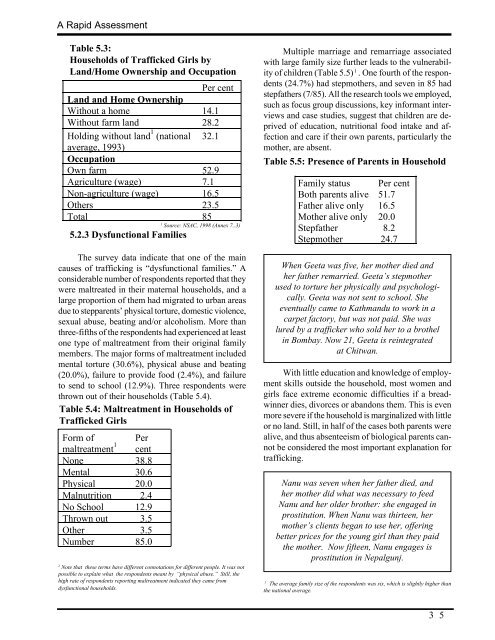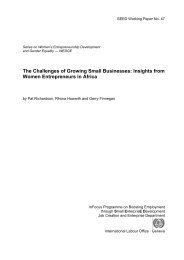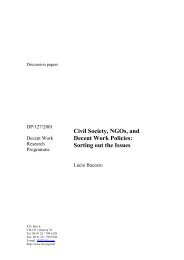Nepal Trafficking in Girls With Special Reference to Prostitution: A ...
Nepal Trafficking in Girls With Special Reference to Prostitution: A ...
Nepal Trafficking in Girls With Special Reference to Prostitution: A ...
You also want an ePaper? Increase the reach of your titles
YUMPU automatically turns print PDFs into web optimized ePapers that Google loves.
A Rapid Assessment<br />
Table 5.3:<br />
Households of Trafficked <strong>Girls</strong> by<br />
Land/Home Ownership and Occupation<br />
Per cent<br />
Land and Home Ownership<br />
<strong>With</strong>out a home 14.1<br />
<strong>With</strong>out farm land 28.2<br />
Hold<strong>in</strong>g without land 1 (national 32.1<br />
average, 1993)<br />
Occupation<br />
Own farm 52.9<br />
Agriculture (wage) 7.1<br />
Non-agriculture (wage) 16.5<br />
Others 23.5<br />
Total 85<br />
5.2.3 Dysfunctional Families<br />
The survey data <strong>in</strong>dicate that one of the ma<strong>in</strong><br />
causes of traffick<strong>in</strong>g is “dysfunctional families.” A<br />
considerable number of respondents reported that they<br />
were maltreated <strong>in</strong> their maternal households, and a<br />
large proportion of them had migrated <strong>to</strong> urban areas<br />
due <strong>to</strong> stepparents’ physical <strong>to</strong>rture, domestic violence,<br />
sexual abuse, beat<strong>in</strong>g and/or alcoholism. More than<br />
three-fifths of the respondents had experienced at least<br />
one type of maltreatment from their orig<strong>in</strong>al family<br />
members. The major forms of maltreatment <strong>in</strong>cluded<br />
mental <strong>to</strong>rture (30.6%), physical abuse and beat<strong>in</strong>g<br />
(20.0%), failure <strong>to</strong> provide food (2.4%), and failure<br />
<strong>to</strong> send <strong>to</strong> school (12.9%). Three respondents were<br />
thrown out of their households (Table 5.4).<br />
Table 5.4: Maltreatment <strong>in</strong> Households of<br />
Trafficked <strong>Girls</strong><br />
Form of<br />
maltreatment 1<br />
Per<br />
cent<br />
None 38.8<br />
Mental 30.6<br />
Physical 20.0<br />
Malnutrition 2.4<br />
No School 12.9<br />
Thrown out 3.5<br />
Other 3.5<br />
Number 85.0<br />
1 Source: NSAC, 1998 (Annex 7..3)<br />
2 Note that these terms have different connotations for different people. It was not<br />
possible <strong>to</strong> expla<strong>in</strong> what the respondents meant by “physical abuse.” Still, the<br />
high rate of respondents report<strong>in</strong>g maltreatment <strong>in</strong>dicated they came from<br />
dysfunctional households.<br />
Multiple marriage and remarriage associated<br />
with large family size further leads <strong>to</strong> the vulnerability<br />
of children (Table 5.5) 1 . One fourth of the respondents<br />
(24.7%) had stepmothers, and seven <strong>in</strong> 85 had<br />
stepfathers (7/85). All the research <strong>to</strong>ols we employed,<br />
such as focus group discussions, key <strong>in</strong>formant <strong>in</strong>terviews<br />
and case studies, suggest that children are deprived<br />
of education, nutritional food <strong>in</strong>take and affection<br />
and care if their own parents, particularly the<br />
mother, are absent.<br />
Table 5.5: Presence of Parents <strong>in</strong> Household<br />
Family status Per cent<br />
Both parents alive 51.7<br />
Father alive only 16.5<br />
Mother alive only 20.0<br />
Stepfather 8.2<br />
Stepmother 24.7<br />
When Geeta was five, her mother died and<br />
her father remarried. Geeta’s stepmother<br />
used <strong>to</strong> <strong>to</strong>rture her physically and psychologically.<br />
Geeta was not sent <strong>to</strong> school. She<br />
eventually came <strong>to</strong> Kathmandu <strong>to</strong> work <strong>in</strong> a<br />
carpet fac<strong>to</strong>ry, but was not paid. She was<br />
lured by a trafficker who sold her <strong>to</strong> a brothel<br />
<strong>in</strong> Bombay. Now 21, Geeta is re<strong>in</strong>tegrated<br />
at Chitwan.<br />
<strong>With</strong> little education and knowledge of employment<br />
skills outside the household, most women and<br />
girls face extreme economic difficulties if a breadw<strong>in</strong>ner<br />
dies, divorces or abandons them. This is even<br />
more severe if the household is marg<strong>in</strong>alized with little<br />
or no land. Still, <strong>in</strong> half of the cases both parents were<br />
alive, and thus absenteeism of biological parents cannot<br />
be considered the most important explanation for<br />
traffick<strong>in</strong>g.<br />
Nanu was seven when her father died, and<br />
her mother did what was necessary <strong>to</strong> feed<br />
Nanu and her older brother: she engaged <strong>in</strong><br />
prostitution. When Nanu was thirteen, her<br />
mother’s clients began <strong>to</strong> use her, offer<strong>in</strong>g<br />
better prices for the young girl than they paid<br />
the mother. Now fifteen, Nanu engages is<br />
prostitution <strong>in</strong> <strong>Nepal</strong>gunj.<br />
1 The average family size of the respondents was six, which is slightly higher than<br />
the national average.<br />
3 5

















